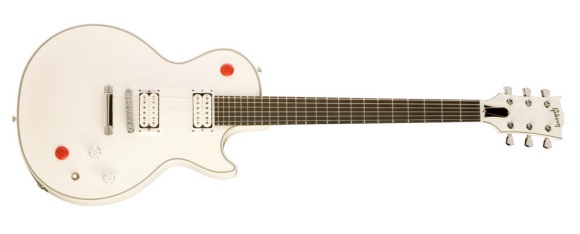Gibson’s Signature Series Advances Apace
 Hot on the heels of the spate of Angus Young SG models, Gibson announce this, the Buckethead Signature Les Paul.
Hot on the heels of the spate of Angus Young SG models, Gibson announce this, the Buckethead Signature Les Paul.
With 28 solo albums under his KFC meal-deal hat and having played on countless other albums by countless other bands and solo artists, nobody can accuse Buckethead of being a fried chicken-eating couch-potato. He’s showed up on a crapload of ‘Superest Shredders Of All Time In The Universe Ever’ lists and now, he’s got his own signature Les Paul.
Sometimes, when Gibson do ‘contemporary’, they make a mess of it. Rumours are rife about the new Dusk Tiger model that’s imminent and the images so far don’t fill me with confidence. This time, however, they seem to have managed a modern looking guitar without buggering everything up. Possibly, that’s because they haven’t strayed too far from the tried and trusted formula.
What you get is essentially a Les Paul, albeit one with some modern twists. The finish is high-gloss Alpine White over the traditional mahogany body/maple top combination that yields so much magic. The body is chambered so you can avoid the worst of the back-ache that some Les Pauls can induce.
Fingerboard is ebony and bears no position markers on the front. Combined with the white of the body, it gives a nice, sleek, monotone impression. Worth noting is that this is a 24-fret neck (jumbo frets) with a, longer, 27″ scale length. The nut is Corian and its a bit wider than usual at around 1.715″.
The pickups are ceramic-magnetted units – a 496R at the neck and a 500T installed at the bridge position. Hot pickups to match the tone to the modern looks. Pickups are controlled by a single, master volume and tone. The tone control is a push/pull pot that splits the bridge pickup for single-coilesque sounds.
You’re wondering about those red buttons, aren’t you? You can’t deny they’re eye-catching. They’re ‘arcade-style’ pushes that act as kill-switches to mute the output for all your stuttery, helicoptery needs.
Some signature models are barely different to the standard production models – you could argue that they’re barely signature at all and argue about their raison d’être. Others are so crazily quirky that none but the most ardent fans would buy one. To my mind, the success of a signature model lies in how much of a home it can make outside of that ‘ardent fan-base’. If someone unfamiliar with the endorsee would happily buy and play a signature model, I think that makes it a good one.
And I think that makes this a good one.
Thoughts?

More at Gibson.

